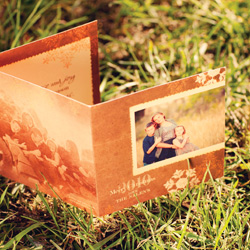It’s November, and before you know it, your mailbox will begin to fill up with holiday greetings.
Ever since the first Christmas card was sent in the 1840s, they have represented a way of sharing holiday cheer with friends and family. The concept of the Christmas card was actually started in England by Queen Victoria and is still part of the royal family’s holiday tradition today. Their typical holiday greeting is a portrait or portraits that depict significant personal events of the year. In contrast, the typical card from America’s “First Family” showcases a scene from the White House as rendered by a prominent American artist.
It seems that the British concept of the personal portrait has become the most common holiday greeting in America, as photography studios across the country fill their schedules with families wanting to capture updated family portraits. While home decor will be the lasting token from the session, Christmas cards showcasing the portraits are at the top of many families’ lists. A bi-fold card with a photograph on the front and a holiday greeting on the inside has been the most typical concept for years, but times and technology are changing.
 The look of Christmas greetings has really begun to evolve. As long as it can fit in a flat envelope, anything seems to be an option. As portrait studios prepare for a busy holiday season, they search for the newest concepts in holiday greetings to fill clients’ requests. Many families come year after year, longing for this year’s card to outdo the last. Clients talk about their friends’ comments throughout the year and can’t wait to see what will show up in their mailboxes this year. I’ve even heard of some families holding their own contest to vote on the “Christmas greeting of the year.”
The look of Christmas greetings has really begun to evolve. As long as it can fit in a flat envelope, anything seems to be an option. As portrait studios prepare for a busy holiday season, they search for the newest concepts in holiday greetings to fill clients’ requests. Many families come year after year, longing for this year’s card to outdo the last. Clients talk about their friends’ comments throughout the year and can’t wait to see what will show up in their mailboxes this year. I’ve even heard of some families holding their own contest to vote on the “Christmas greeting of the year.”
So with that in mind, it is no wonder that the look of Christmas greetings is changing. This year, most of the new concepts include options that not only allow you to share portraits with friends and family, but also turn cards into ornaments to hang on the Christmas tree for years to come. These concepts include a metal snowflake, a pop-up globe or a fun strand of lights.
As the styles of holiday greetings have changed, the arrival date has also begun to change. The main season for mailing holiday greetings has traditionally been the day after Thanksgiving through December 20th, which would most likely guarantee delivery before Christmas Day. But as family dynamics change and time constraints become a greater challenge, other solutions have emerged. New Year’s and Valentine’s Day are now seen as popular options for holiday greetings.
Families that really want to send a greeting to share their most recent portraits no longer find guilt in sending them a little later. For many families, the week between Christmas and New Year’s Day is often the only time they can get together to take an updated portrait. The nice thing about a New Year’s or Valentine’s greeting is that they tend to make a bigger impact on their recipients, as they aren’t lost in the shuffle of cards that arrive each day during the typical holiday greeting season.
So get creative this year, and spread the holiday cheer! iBi
Julia Woods is president and chief photographer of PortraitLife, located in Washington, Illinois. Visit portraitlife.com for more information.
1843: The first commercial Christmas card was commissioned in London. It proved controversial due to the picture of a family with a small child sipping wine together.
1875: The first American printer began offering Christmas cards. Prior to this, Americans had to import greeting cards from England.
1915: Hallmark, founded five years earlier, issued its first Christmas cards.
1953: President Eisenhower issued the first official White House card.
Source: wikipedia.org, hallmark.com


